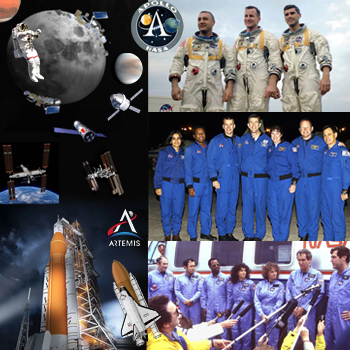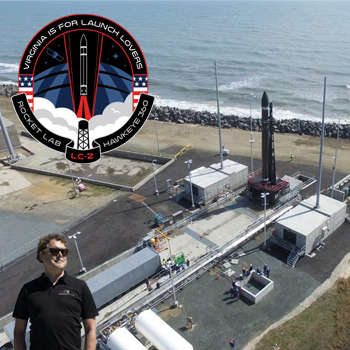Astronaut ‘Remember the Future’ Day
Honoring the past and looking to the future of human space exploration, NASA will host the Day of Remembrance 2023 on January 26 for the 56th observation of Apollo 1 loss of Virgil “Gus” Grissom, Edward H. White and Roger B. Chaffee; the Challenger STS-51L 37th observation loss of Francis R. “Dick” Scobee, Michael J. Smith, Christa McAuliffe, Ellison S. Onizuka, Judith A. Resnick, Ronald E. McNair, and Gregory B. Jarvis; and the Columbia STS-107 20th observation loss of Richard D. Husband, Laurel Clark, Ilan Ramon, William C. McCool, Michael P. Anderson, David M. Brown and Kalpana Chawla. Nearly 630 people have now flown above the 100-km Kármán line, 12 men walked on the Moon, 76 women have completed spaceflights, and citizens of 44 countries have flown in space – with many other nations and groups aspiring for and in need of representation. USA Artemis program is working toward SLS Flight #2 NET May 2024 which is set to carry a crew of 3 USA and 1 Canada Astronauts on a circumlunar flight. Japan may join a crewed Moon surface mission for Artemis 4-6, currently set to launch 2028-30. Tiangong Space Station has seen 3 Taikonaut crews so far, with a plan for an International Astronaut to join Shenzhou-17 or 18. Future destinations for next-gen spacefarers should include private space stations, lunar base camps, flybys of Mars and Venus, followed by Solar System Complete exploration. (Image Credits: NASA, CNSA, ISS Partners) |
MONDAY☆ Jan 23 — ISS, ~415-km LEO: Expedition 68 seven-member crew working with Food Physiology and ISS HAM experiments; unpiloted Soyuz MS-23 scheduled to launch mid-Feb – extending mission MS-22 crew Prokopiev, Petelin and Rubio to 1 full year in space. ☆ Jan 23 — Tiangong Space Station, ~390-km LEO: Shenzhou 15 three-member crew aboard until at least May 29 should see Shenzhou 16 crew overlap of 4 days, welcome upgraded Tianzhou 6 cargo ship with greater carrying capacity NET April. Highlights… o NewSpace: ICON, Launcher & Relativity Space building lunar habitat prototypes, engines, rockets with additive manufacturing processes; Toronto-based Magnestar to develop RF avoidance system tool with US$1.1M pre-seed funding; World View to offer shares on NYSE via SPAC ($350M expected valuation) to fund Earth observation and near-space tourism. ☆ Solar System: JPL revising Lunar Flashlight propulsion schedule with arrival in lunar orbit expected NET May while ASU team working to regain control of LunaH-Map; Jupiter orbital migration may be cause of L4 / L5 Trojan asteroid cluster asymmetry per NYU Abu Dhabi-led study; CNSA to launch Queqiao-2 cislunar comms relay in early 2024, ahead of CE-6. ☆ Galaxy: Proposed NASA Habitable Worlds Observatory may search for Earth-like planets in IR, UV and optical spectra from L2 in early 2040’s; Astronomers at Australian SKA Pathfinder and Parkes Observatory estimate 1,500+ supernova remnants in galaxy remain undiscovered after 20 new remnants found in 1% area of MWG. o Global: Hong Kong Aerospace and Touchroad International of Shanghai to build commercial spaceport in Horn of Africa nation of Djibouti at $1B cost over 5 years; Japan & USA to closely cooperate on space exploration under framework agreement; Spaceport Esrange seeking customers while Sami leader expresses concerns of Arctic militarization and effects on Reindeer. ● USA: NASA OIG recommends 10 steps to ensure international Artemis partnerships are coordinated a well-organized manner; SpaceX eyes expansion in Wichita KS in support of Super Heavy / Starship per President Gwynne Shotwell; Rocket Lab requests DoD reconsider heavy-lift launch vehicle, allowing company to join SpaceX and ULA in bidding for national security contracts. ● Hawai’i: Keck Observatory and VLT being used together to characterize black hole J2157, now thought to be 8,000x mass of Sgr A*, 200,000,000,000 km in diameter; Prospects for Thirty Meter Telescope construction buoyed by well-received town hall discussion on Maunakea use including 3 MKSOA members at AAS 241 in Seattle. |
 |
● = Terrestrial and… o = International terrestrial events
☾ = Moon activity ★ = Space and… ☆ = International space / astro events in Hawaii Standard Time unless noted. Add 10 hours to obtain UT (‘Universal Time’). |
Weekly Planet Watch – Morning Planets: Mercury (SE); Evening Planets: Venus (WSW), Mars (S), Jupiter (SW), Saturn (WSW), Uranus (S), Neptune (W).
Rocket Lab Readies First Flight from USA While Building Next Launch Vehicle, Planning Interplanetary Mission
|
★ Jan 23 — Rocket Lab, Launch Electron / HawkEye 360, Launch Complex 2, Wallops Island VA: Launch window opens for Rocket Lab first launch attempt from USA, mission dubbed ‘Virginia is for Launch Lovers’, carrying HawkEye 360 satellites; window 18:00-20:00. o Jan 23 — ESA, Hybrid / Paris, France and Online: Director General Josef Aschbacher Annual Press Conference. ● Jan 23-27 — American Institute of Aeronautics and Astronautics, Lockheed Martin, Boeing, Hexagon, Bastion Technologies, Hybrid / National Harbor MD and Online: 2023 SciTech Forum: Ignite the Future: Explore the Frontiers of Aerospace. ☆ Jan 23 — Moon: 3.6° SE of Saturn and 3.2° SE of Venus, 00:00. Continued From… ● Oct 15 – Jun 15, 2023 — International Space Elevator Consortium, Online: Space Elevator Academic Challenge: Improving Humanity’s Future; for students 17-25. ● Dec 1 – Jan 31, 2023 — JPL, NASA, Online / Pasadena CA: Prepare for the Science Fair; video series for students in grades 3-12, teachers and parents. ☾ Dec 11 – Apr 25, 2023 — Hakuto-R / ispace Mission 1, Lunar Landing Trajectory: Carrying UAE Rashid 10-kg rover, 0.25-kg JAXA rover, Hakuto-R performing orbital control maneuvers to reach Lunar Orbital Insertion, followed by Moon touchdown nominally ~4.5 months after launch. ● Jan 18 – May 11 — Wichita State University, Wichita KS and Online: 2023 Interstellar Seminar ‘LASI 150G’; 1-credit hour seminar begins today; every Wednesday 14:30-15:20, led by Prof. Mark Schneegurt. TUESDAY☆ Jan 24 — JAXA, Launch H-2A / IGS Radar 7, Tanegashima Space Center, Japan: H-2A rocket, designated H-2A F46, to launch IGS Radar 7 radar reconnaissance satellite for Japan Information Gathering Satellites. ★ Jan 24 — SpaceX, Launch Falcon 9 / Starlink 5-2, SLC-40, Cape Canaveral SFS FL: Falcon 9 to launch next batch of Starlink internet satellites for SpaceX; 04:52. ● Jan 24 — Night Sky Network, Astronomical Society of the Pacific, Online: NSN Webinar Series: Astronomy Picture of the Day (APOD): Postcards from the Universe 2022; 18:00 PST. |
o Jan 24-25 — Business Bridge Europe, Brussels, Belgium: 15th European Space Conference: Securing the Future of Europe in Space; at Egmont Palace.
● Jan 24-26 — NASA Small Bodies Assessment Group (SBAG), Hybrid / Pasadena CA and Online: 28th SBAG Meeting; at Infrared Processing and Analysis Center on Caltech campus.
☆ Jan 24 — Moon: 2.42° SE of Neptune, 23:00.
☆ Jan 24 — Apollo Asteroid 2019 BO2: Near-Earth Flyby (0.030 AU)
☆ Jan 24 — Apollo Asteroid 2019 BZ4: Near-Earth Flyby (0.042 AU)
☆ Jan 24 — Apollo Asteroid 2023 AB1: Near-Earth Flyby (0.073 AU)
WEDNESDAY
● Jan 25 — NASA, Houston TX and Online: NASA / SpaceX Crew-6 Mission Overview Briefing from Johnson Space Center; featuring crew Andrey Fedyaev, Warren “Woody” Hoburg, Stephen Bowen, Sultan Al Neyadi; starts 12:00, live coverage available.
☆ Jan 25 — Moon: 1.63° SE of Jupiter, 18:00.
☆ Jan 25 — Apollo Asteroid 2023 AM1: Near-Earth Flyby (0.029 AU)
☆ Jan 25 — Apollo Asteroid 2011 CO14: Near-Earth Flyby (0.079 AU)
THURSDAY
☆ Jan 26 — ISS, In-Flight Education Event, ~415-km LEO and Online: Expedition 68 Event with the Boys and Girls Club of the Flathead Reservation and Lake County in Ronan, Montana and NASA Flight Engineer Nicole Mann; starts 12:00, live coverage available.
● Jan 26 — NASA, Nationwide / Online: NASA Day of Remembrance 2023; held the last Thursday of January to honor the Astronauts of Apollo 1, Space Shuttle Challenger, and Space Shuttle Columbia.
o Jan 26 — Airbus, ESA, Bremen, Germany: Artemis press event; clean room tour to see the European Service Modules 3, 4 and 5.
☆ Jan 26 — Apollo Asteroid 2020 BZ14: Near-Earth Flyby (0.022 AU)
☆ Jan 26 — Aten Asteroid 2021 BZ: Near-Earth Flyby (0.088 AU)
FRIDAY
● Jan 27 — Apollo 1 56th Observation, Nationwide USA: Increasing space awareness and education, remembrances and events honor three Apollo 1 crew members lost during a launch pad test: Command Pilot Virgil “Gus” Grissom, Senior Pilot Edward H. White and Pilot Roger B. Chaffee.
SATURDAY
● Jan 28 — Challenger STS-51L 37th Observation, Nationwide USA: Educational and ceremonial events held worldwide to advance space technology / education and honor 7 crew members killed in Shuttle accident 28 January 1986: Commander Francis R. “Dick” Scobee, Pilot Michael J. Smith, Astronaut Christa McAuliffe (the 1st ‘Teacher in Space’), Mission Specialists Ellison S. Onizuka, Judith A. Resnick and Ronald E. McNair, along with Payload Specialist Gregory B. Jarvis.
o Jan 28-29 — Students for the Exploration and Development of Space (SEDS-Canada), PolyOrbite, Montreal, Québec, Canada: Canada Space Conference: Space Through the Looking Glass.
o Jan 28-29 — Malaysia National Planetarium (Planetarium Negara), Australian National University, Academia Sinica Institute of Astronomy and Astrophysics, et al, Kota Kinabalu & Sabah, Malaysia: Global Malaysia Astronomers Convention 2023 (Part 3).
☆ Jan 28 — Moon: At first quarter, 05:19; 0.92° N of Uranus, 18:00.
☆ Jan 28 — Aten Asteroid 2021 BZ: Near-Earth Flyby (0.088 AU)
SUNDAY
☆ Jan 29 — Apollo Asteroid 2022 SO113: Near-Earth Flyby (0.026 AU)
☆ Jan 29 — Apollo Asteroid 2017 CP: Near-Earth Flyby (0.056 AU)

